Bone tissue extension during dental implants
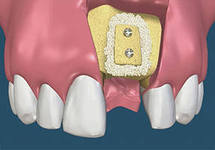
Bone deficiency or atrophy is a fairly common problem that patients usually encounter when preparing for implant placement.
In this situation, the doctor has to look for alternative ways to solve the problem or to carry out bone growth during dental implants.
With a decrease in the volume of bone tissue of the upper jaw, there is a risk of damage to the maxillary sinus when installing implants.
The constructions will be longer than the bone and this can lead to rupture of the maxillary sinus and its infection, which in turn will cause sinusitis or chronic runny nose.
Options for solving the problem of the upper jaw:
- Dental implant without bone growth.
- Sinus lift surgery.
- In case of atrophy of the bone tissue of the lower jaw, the implantologist may encounter the problem of the proximity of the mandibular nerve. Its damage can cause such unpleasant consequences as: complete or partial loss of sensitivity of the tongue, lips, lower face and the presence of problems with pronunciation of sounds, swallowing, etc.
Solving the problem of insufficient bone in the lower jaw:
- Implantation of implants in the anterior part of the jaw (possible only with a complete adentia of the jaw and is used to fix a removable denture).
- Placement of implants near the nerve.
- Changing the position of the nerve.
- Dental implants with bone extension of the lower jaw.
Why is bone grafting performed?
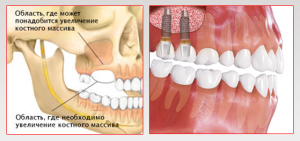
To implant a titanium structure, a sufficient height and width of the bone tissue is necessary.
It depends on whether the implant will stand and serve its master for many years.
When deciding on the implantation of teeth without bone growth according to the classical protocol, it is necessary to fulfill a condition such as the presence of bone height of at least ten millimeters.
An indication for bone building is an insufficient amount of bone tissue.
The concept of bone failure in each individual case is relative.
For instance:
- To install implants in the anterior part of the jaw with further fixation on them of a removable structure, bone grafting is not necessary.
- If it is required to carry out non-removable prosthetics, and at the same time there is not enough bone tissue, then this case requires bone growth.
Carrying out bone grafting is a necessary measure also because uncompensated bone atrophy can lead to such consequences as:
- A pathological displacement of the teeth, which over time can provoke their loosening and loss.
- Distortion of facial expressions, violation of articulation and speech.
- A violation of chewing, which can cause digestive diseases.
- Distortion of the contour of the face, the formation of wrinkles, lipstick.
Thus, bone grafting in the presence of atrophic changes in bone tissue is the most important treatment and prophylactic operation.
How to build bone
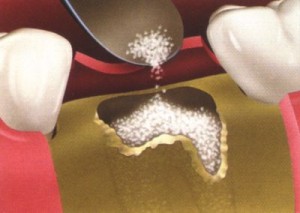
Modern technologies for bone restoration allow the installation of implants in any part of the jaw bone, regardless of its condition.
To date, such methods of bone tissue growth are used as:
- Transplantation of bone blocks.
- Bone regeneration.
- Sinus - lifting.
- Bone grafting.
Directed Bone Regeneration
When it is carried out, bone tissue is transplanted in the form of a membrane, which has a high degree of biocompatibility and provides bone formation.
- Such membranes are made from collagen fiber.
- They are absorbable and non-absorbable.
- After implantation of the membrane, the wound surface is sutured.
After bone tissue is formed, implantation is performed.
Bone block implantation
After tooth extraction, a large hole remains.
When installing the implant so that it is better fixed in the bone tissue, in some cases, bone materials are used.
Bone grafting
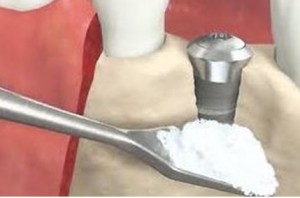
Used less often than previous methods.
It is a bone extension using a graft.
- The essence of the operation is to implant bone tissue taken from the site of the lower jaw (chin area) or upper (behind the wisdom teeth).
- The implanted bone fragment is fixed with titanium screws.
After 4-6 months, the screws are removed and implantation is carried out.
How is
- An incision is made in the gums.
- With the help of special tools, bone tissue is split and extended.
- Osteoplastic material is immersed in the cavity formed.
- Graft fixation with titanium screws.
- Filling of intermediate defects with crumb bone.
- Applying a special membrane and suturing the gums.
Implants can be inserted after about six months.
Video: “Bone grafting. Methods
Sinus lift
The goal is to increase bone volume by raising the maxillary sinus.
The main indications of bone tissue growth by sinus lifting are:
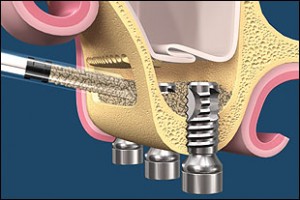
- Lack of pathology at the site of the operation.
- The presence of bone in a volume appropriate for the specific procedure necessary for the primary fixation of intraosseous implants.
- No risk of possible complications during surgery.
The operation is considered contraindicated if the patient has at least one of the following diseases and features of the anatomical structure:
- The presence of multiple septa in the maxillary sinuses.
- Chronic runny nose.
- The presence of polyps.
- With sinusitis.
- Poor bone condition.
- If there is a history of surgical intervention in the region of the maxillary sinuses.
- The patient is a heavy smoker.
How is
There are two methods of sinus lifting:
- Open.
- Closed.
Open sine - lifting
The operation is considered quite complicated.
Indication: severe bone deficiency in the lateral areas of the upper jaw.
Stages:
- An implantologist makes a small hole in the outer wall of the sinus without affecting the mucosa.
- Then the mucous membrane of the sinus rises to the required height.
- The free space formed is filled with building material.
- The previously detached part of the bone tissue and mucous membrane is returned to its place and sutured.
After some time, the necessary volume of bone is formed, after which implantation is performed.
Closed Sinus - Lifting
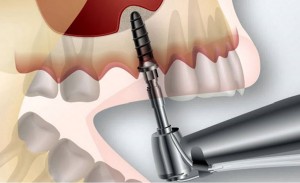
It is used for implantation with a deficiency of 1 - 2 mm of bone tissue in height.
Stages:
- First, a bone bed is prepared for the implant: a hole is formed along the length, not reaching 1–2 mm of the maxillary sinus.
- Using the necessary tools, the implantologist, by lightly tapping, displaces the remaining fragment of the bone into the maxillary sinus, thus raising the periosteal mucous flap.
- Through the hole formed deep into the bed, osteoplastic material is introduced, after which the implant is installed.
Advantages and disadvantages of sinus lift
- The ability to restore bone volume.
- The closed type of operation allows bone tissue to be built in a less traumatic way.
- The opportunity to acquire new teeth that are fully capable of replacing real teeth.
An unsuccessful sinus lift can have sad consequences:
- Damage to the sinus, which in the future can cause chronic runny nose.
- Sinking of the structure deep into the maxillary sinus, which will be the reason for its removal.
- Will lead to the development of the inflammatory process in the sinus.
A minus can also be the fact that the postoperative period and rehabilitation of the patient will be quite long.
In addition, the patient must comply with some mandatory requirements, for example, you will need to avoid sneezing and coughing, because this can lead to the loss of an artificial bone or implant.
After the operation, it is not recommended to consume solid, cold or hot food, visit a bathhouse or sauna, do hard work, play sports, dive into the hearth, drink from a tub, sneeze, blow your nose, make air travel.
Building Materials
To restore the lost volume of bone tissue, a bone graft is used.
To do this, use:
- The bone tissue of the patient himself is an autograft. The patient takes a section of bone tissue from the chin of the jaw, outgrowths on the jaws, tubercles of the upper jaw, ilium, ribs. Natural bone takes root in the human body most successfully and quickly.
- Donor bone tissue is an allograft. Another person can become a donor. But more often the cadaveric bone serves as a material for building. Before installing the donor material, the implanted bone undergoes special treatment to eliminate the risk of complications. Healing proceeds more slowly due to the lack of viable cells.
- Bone tissue of animal origin - xenograft. Such tissue is more affordable than human. Resorption and replacement of xenografts with new bone tissue is very slow.
- Alloplasts are materials of artificial origin. These include hydroxyappatite and its derivatives, bioceramics and others.
Reviews
- I am 60 years old. Installed two implants on the lower jaw. Since the teeth were lost a long time ago, almost no bone was left. Before implantation, they suggested making osteoplasty a bone block transplant. After the operation, there was a slight swelling and bruising that went away within about a week. There was no great discomfort. Two and a half months after implantation of the bone, implants were placed. After another month and a half, prosthetics were performed with temporary dental crowns.
- I am 35 years old. After giving birth, she lost two teeth in the lower jaw. After tomography, it turned out that the volume of bone tissue does not allow to install implants of the right size. She didn’t want to install implants that were small in diameter, so she had to have osteoplasty. An implantologist proposed to do osteoplasty at the same time as implantation. After the operation, for some time there was discomfort, swelling, slight cyanosis in the lower jaw.Two months later, the implants completely took root, and the doctor installed gum formers. Two weeks later, the dentist took casts and made crowns.
- I have long wanted to put implants. I went to the doctor. After the examination, it turned out that bone grafting should be done. On the upper jaw, sinus lift was done, and on the lower jaw, bone was added. About ten days after the operation I felt severe discomfort, drank painkillers. His face was bruised and swollen. Three months later, they installed implants, and a month later they performed prosthetics: they installed temporary crowns.